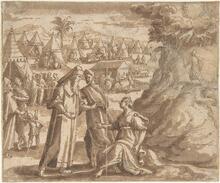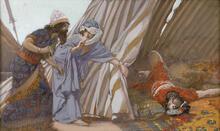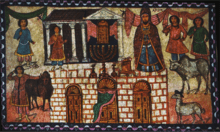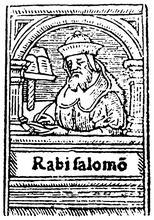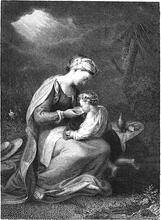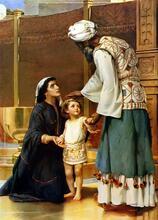Jochebed: Midrash and Aggadah
The midrash portrays Jochebed as a wise woman who was righteous and God-fearing. She is identified as Shiphrah, one of the Hebrew midwives who saved the newborn baby boys from Pharaoh. By merit of her good deeds, she gave birth to the three leaders of the Exodus generation: Moses, Aaron, and Miriam. Part of her reward was an extremely long life, living to witness the positions of leadership held by her children, and she was even one of the Israelites who entered the land of Canaan.
The A type of non-halakhic literary activitiy of the Rabbis for interpreting non-legal material according to special principles of interpretation (hermeneutical rules).midrash portrays Jochebed as a wise woman who was righteous and God-fearing. By merit of her good deeds, she gave birth to the three leaders of the Exodus generation: Moses, Aaron, and Miriam. A number of miracles were performed for Jochebed in connection with the birth of Moses: she bore him at the age of one hundred and thirty, and God restored her youth and her beauty. Jochebed enjoyed longevity, living to witness the positions of leadership held by her children, and was even one of the Israelites who entered the land of Canaan.
The Conception and Birth of Jochebed
In addition to her given name, the Torah she-bi-khetav: Lit. "the written Torah." The Bible; the Pentateuch; Tanakh (the Pentateuch, Prophets and Hagiographia)Torah also designates Jochebed as the “daughter of Levi” (Num. 26:59): “The name of Amram’s wife was Jochebed daughter of Levi, who was born to Levi in Egypt.” The midrash adds that she was conceived on the way to Egypt, and was born between the walls (at the entrance to Egypt). Although the Torah asserts that Jacob’s household who came to Egypt numbered seventy souls, the Rabbis noted that only sixty-nine individuals are listed in Gen. 46. One of the explanations of this discrepancy is that Jochebed completed the number seventy; she was not included in the list because she was still in her mother’s womb (Gen. Rabbah 94:9).
Her Marriage to Amram
The question of Jochebed’s kinship to Amram arises from the statement in Ex. 6:20: “Amram took to wife his father’s sister Jochebed.” Amram was the son of Kohath and the grandson of Levi, while Jochebed was the daughter of Levi, and therefore his aunt. The Lit. "teaching," "study," or "learning." A compilation of the commentary and discussions of the amora'im on the Mishnah. When not specified, "Talmud" refers to the Babylonian Talmud.Talmud discusses this relationship in the context of the incest prohibitions in Lev. 18:12–14 (BT Sanhedrin 58b).
Jochebed bore Amram three righteous offspring. Each was a prophet, and each served Israel (provided them physical succor): by merit of Moses, the Israelites were given the manna; by merit of Aaron, clouds of glory surrounded the Israelites and protected them during their journeying in the wilderness; and by merit of Miriam, the well accompanied them wherever they went. Accordingly, Prov. 14:1: “The wisest of women builds her house” is applied to Miriam (Midrash Proverbs 14:1). The midrash apparently understands “builds her house” in a broad sense, because Jochebed’s wisdom in the raising of her own children led to the building and firm establishment of the entire people of Israel.
Shiphrah Is Jochebed
The Rabbis identify Jochebed with Shiphrah, one of the two Hebrew midwives (Shiphrah and Puah) who delivered the children of the Israelites during the Egyptian servitude. The Torah relates that the midwives did not fulfill Pharaoh’s command because they feared God, who rewarded them for their actions: “He established households [battim] for them” (Ex. 1:21), which the Rabbis understand as priestly and Levitical households, or as royal households. Jochebed herself was from the tribe of Levi, and her two sons Aaron and Moses attained the High Priesthood and the scepter of royalty (BT Suspected adulteressSotah 11b).
According to one midrashic view, Shiphrah and Puah were mother and daughter— Jochebed and Miriam, while another states that they were daughter-in-law and mother-in-law—Jochebed and Elisheba daughter of Amminadab. Jochebed was given the name “Shiphrah” because she would cleanse (meshaperet) the newborn, by washing it and cleaning it after birth; another etymological explanation is that, by merit of her deeds, the Israelites were fruitful [she-paru] and multiplied in her time (Sifrei on Numbers, para. 78). Yet another tradition explains that she shiprah her actions before God (i.e., performed good deeds that were pleasing to the Lord). An additional midrashic explanation of her name is that she smoothed over (shiprah) her daughter Puah’s words. The latter had spoken impudently to Pharaoh, who sought to kill her in his anger. Shiphrah placated him, saying: “Do you pay attention to such a one as her? She is a witless baby.” Still another notion bases its understanding of the name on Job 26:13: “By his wind the heavens were calmed [shifrah].” The verse describes the heavens that were created by God for Israel, and it was Shiphrah who returned Israel to their Father in heaven (Eccl. Rabbah 7:3; Ex. Rabbah 1:13).
Ex. 1:17 relates that “the midwives, fearing God, let the boys live”; their reward for fearing God, according to the midrash, is Torah: because Jochebed feared the Lord, she gave birth to Moses, through whom the Torah was given (Ex. Rabbah 1:16).
Her Divorce and Remarriage to Amram
Ex. 2 tells of the birth of Moses. V. 1 begins with the marriage of Jochebed and Amram, and then the reader is immediately told of Moses’s birth, concealment and rescue. This sequence omits a lengthy period of time, for Jochebed and Amram already had two other children (Aaron and Miriam) when Moses was born. The Torah seemingly chose to concentrate on the birth of Israel’s deliverer, and therefore did not mention his two elder siblings. The Rabbis resolve this abbreviated chronology by stating that Jochebed and Amram divorced, and Ex. 2:1 portrays their remarriage.
According to this tradition, Amram was the leading scholar of the generation. When he saw that Pharaoh had decreed that all the boys be cast into the Nile, he proclaimed: “Are we laboring in vain?” (we give birth to sons who will eventually be killed), and so he divorced his wife. All Israel saw this, and in consequence they also divorced their wives. Miriam, who was six years old at the time, said: “Father, father, your decree is harsher than that of Pharaoh. Pharaoh only decreed against the males, but you have decreed against both the males and the females [since all the Israelites withdrew from their wives, neither sons nor daughters would come into the world]. Pharaoh decreed only for this world, but you decreed both for this world and the next [a baby that was born and died as a result of Pharaoh’s decree would merit the World to Come, but an unborn child would not attain this]. It is doubtful whether the decree of the wicked Pharaoh will be fulfilled, but you are righteous, and your decree will undoubtedly be fulfilled.” Amram heeded his daughter, and returned to his wife, whom he remarried in a public celebration with all possible pomp and ceremony: he sat her in a palanquin, Aaron and Miriam danced before her, and the ministering angels proclaimed (Ps. 113:9): “He sets the childless woman [akeret ha-bayit] among her household as a happy mother of children.” Jochebed, who had been uprooted [nitakrah) from her home as a result of the decree of Pharaoh, would now be set happily among her household. All Israel saw this, and they, too, remarried their wives (Mekhilta de-Rabbi Simeon bar Yohai [ed. Epstein-Melamed], p. 6; BT Sotah 12a; Pesikta Rabbati 43).
Amram married Jochebed for the sake of Heaven. That same day God swore that the Ark and the Torah would be entrusted to the arms of his descendants (the Kohathites are the only ones who bore the Ark during the journeying in the wilderness, as is attested in Num. 3:31) (Seder Eliyahu Rabbah 29).
In the Rabbinic retelling, when Amram returned his wife, Jochebed was a hundred and thirty years of age, but signs of youth appeared on her: her body became smoother, her wrinkles were straightened out, and her former beauty was restored. She therefore was called “daughter [bat, which also means “young girl”] of Levi,” because she was once again as a young girl (BT Bava Batra 120a).
The Conception and Birth of Moses
In the Rabbinic exegesis, Jochebed was already pregnant with Moses before Amram divorced her, and the fetus in her womb was three months old when he remarried her. If so, then why does Ex. 2:1–2 state that he “married a Levite woman. The woman conceived and bore a son,” since she conceived before this second marriage? Rather, this verse teaches that Jochebed’s pregnancy was without suffering, just as she gave birth without pain. The Rabbis deduced from this that righteous women are not subject to the decree passed on Eve (that is, the curse of “in pain shall you bear children” [Gen. 3:16] does not apply to them) (BT Sotah 12a).
The narrative of her pregnancy with Moses is amusingly incorporated in an exegesis relating to the time of the Rabbis. Rabbi (Judah ha-Nasi) would sit and expound, and the public was drowsing. The sage, who wanted to awaken them, said: “A single woman in Egypt gave birth to sixty myriads from a single stomach.” There was a pupil there named R. Ishmael son of R. Yose, who asked him: “Was this really so?” He [Rabbi] replied: “This is Jochebed, who bore Moses, who is deemed the equivalent of sixty myriads of Israel” (Song of Songs Rabbah 1:15:3).
When Moses was born, Jochebed saw (Ex. 2:2) “how good [tov] he was.” The Rabbis ask what Jochebed saw that was special in her son, on account of which she sought to save him from Pharaoh’s death decree. According to one opinion, she realized that he was suited to be a prophet; according to another, she saw that he was born circumcised; and according to a third exegetical suggestion, she saw that the entire house was filled with light (BT Sotah 12a). In all three explanations, Jochebed immediately comprehended that her son was meant for greatness and she discerned that he possessed unique spiritual qualities. According to another interpretation, Jochebed named her son “Tov” or “Tobiah,” which was what his parents called him until Pharaoh’s daughter renamed him “Moses” (BT Sotah 12a).
Jochebed succeeded in concealing Moses for three months (Ex. 2:2). In the midrashic exegesis, the Egyptians counted the months of her pregnancy only from her return to Amram; they did not know that she was already in the third month (see above), and so Moses could be hidden in his parents’ home until he had had time to grow and develop.
After three months Jochebed was forced to obey the decree of Pharaoh. The midrash describes in detail how she prepared the ark for Moses. She chose bulrushes, a soft and flexible material that is capable of withstanding contact with both soft and hard objects. She caulked it with “bitumen and pitch” (Ex. 2:3), lining the inside with bitumen, and coating it on the outside with pitch, so that Moses would not smell the bad odor given off by the latter. The wording “she placed it among the reeds” (ibid.) teaches that Jochebed put the ark in a protected place, where bushes and reeds grew. Another midrash has Jochebed building a little canopy for Moses inside the ark, for she said to herself: Perhaps I will not see him under his wedding canopy (BT Sotah 12a–b). This portrayal emphasizes the painstaking attention that Jochebed paid to every detail in the ark. She took leave of her baby with a heavy heart, and tried with all her might to protect him and ensure that he remain alive.
Moses’s Wet Nurse
In the midrashic account, the daughter of Pharaoh saw that Moses was hungry when she drew him from the river. She brought him to all the Egyptian women, but Moses was not willing to nurse from any of them. Moses said: The mouth that will speak with God will not nurse something impure [the milk of non-Jews]. Consequently, Miriam came and offered to the daughter of Pharaoh her mother Jochebed, who was “a Hebrew” (Ex. 2:7, BT Sotah 12b). According to another midrash, Moses rejected the breasts of the Egyptian women because he said: “God will speak with me. The next day the Egyptian women would say that I nursed the one who speaks with the Shekhinah [the Divine Presence]” (Ex. Rabbah 1:25).
The Rabbis say that when the daughter of Pharaoh asked of Jochebed: “Take [helikhi] this child and nurse it for me” (Ex. 2:9), she unwittingly prophesied: the word “helikhi” concealed the truth—“shelikhi hu [he is yours].” Pharaoh’s daughter promised Jochebed (ibid.): “I will pay your wages,” from which the Rabbis learned of Jochebed’s righteousness: like the righteous, she merited the return of what she had lost (her son), and in addition received reward for it (for having nursed him) (Ex. Rabbah 1:25).
Jochebed nursed Moses for twenty-four months (Ex. Rabbah 1:26). God returned her child to her, thus granting her a part of her reward for keeping alive the Hebrew boys (Ex. Rabbah 1:25; for the identification of Jochebed with Shiphrah, see above).
Jochebed entered the Land of Canaan
When Moses was about to die, he addressed God and begged for his life. One of the arguments advanced by Moses was his mother’s suffering. He said: “Master of the Universe! My mother Jochebed’s teeth were blunted by [the death of] two of her children in her lifetime; will more of her teeth be blunted by my death?” But this argument, too, was of no avail (Deut. Rabbah [ed. Lieberman], pp. 40–41). This exegesis teaches of Jochebed’s longevity, and that she was still alive when Moses died. This is corroborated by another early midrash, that states that Jochebed was one of the offspring of Jacob who went down to Egypt and was also among those who entered the land of Canaan (Seder Olam Rabbah 9).



